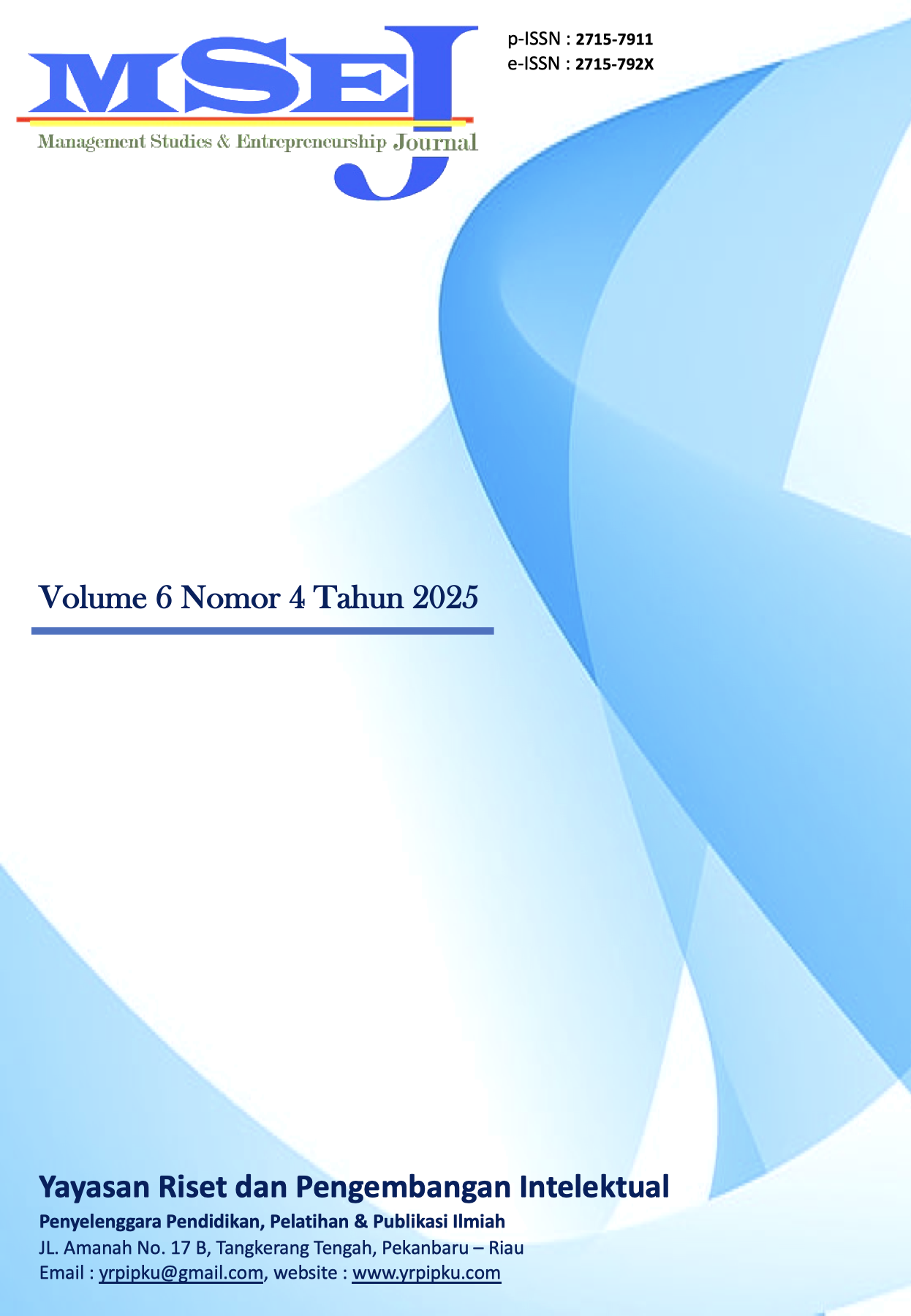Dampak Fintech P2P Lending Terhadap Pembiayaan Bank Umum Di Indonesia
DOI:
https://doi.org/10.37385/msej.v6i4.8092Abstract
Penelitian ini bertujuan untuk menguji dampak Fintech Peer to Peer (P2P) Lending terhadap Pembiayaan Bank Umum di Indonesia. Penelitian ini menggunakan analisis regresi linier sederhana menggunakan data sekunder dengan sampel 5 tahun data statistik fintech P2P lending terkait penyaluran pinjaman P2P lending dan statistik perbankan indonesia terkait total pembiayaan yang disalurkan oleh bank umum di Indonesia, baik konvensional maupun syariah selama periode tahun 2019 sampai dengan tahun 2023. Hasil penelitian menunjukkan bahwa Fintech P2P lending berpengaruh positif dan signifikan terhadap Pembiayaan Bank Umum di Indonesia. Hasil penelitian ini membuktikan bahwa Fintech P2P Lending bukan sebagai ancaman, tetapi sebagai pelengkap (komplementer) Bank Umum di Indonesia yang diwujudkan dengan kolaborasi antara Fintech P2P Lending dan Bank Umum di Indonesia.
References
Adi Ahdiat. (2024). Penetrasi Internet Indonesia Capai 78% pada 2023, Rekor Tertinggi Baru. Katadata.Co.Id, 1–1. https://databoks.katadata.co.id/datapublish/2024/01/30/penetrasi-internet-indonesia-capai-78-pada-2023-rekor-tertinggi-baru
Ariffandi, A. Z., & Trinugroho, I. (2022). The Effect of Fintech Loans on Commercial Bank Margin. Jurnal Keuangan Dan Perbankan, 26(4), 748–757. https://doi.org/10.26905/jkdp.v26i4.7865
Balyuk, T. (2016). Financial Innovation and Borrowers: Evidence from Peer-to-Peer Lending. SSRN Electronic Journal. https://doi.org/10.2139/ssrn.2802220
Batubara, J. P. (2023). PENGARUH FINANCIAL TECHNOLOGY ( FINTECH ) TERHADAP SKRIPSI OLEH?: JUSWANTY PRAMITA BATUBARA PROGRAM STUDI MANAJEME N FAKULTAS EKONOMI DAN BISNIS UNIVERSITAS MEDAN AREA MEDAN PENGARUH FINANCIAL TECHNOLOGY ( FINTECH ) TERHADAP PROFITABILITAS PERBANKAN ( Stu.
Chandrari, G. (2017). Buku Statistik Metode Riset Akuntansi. https://eprints.unmer.ac.id/id/eprint/3849/1/18. Metode Riset Akuntansi dummy.pdf
Chen, D., Lai, F., & Lin, Z. (2014). A trust model for online peer-to-peer lending: a lender’s perspective. Information Technology and Management, 15(4), 239–254. https://doi.org/10.1007/s10799-014-0187-z
Goldstein, I., Jiang, W., & Karolyi, G. A. (2019). To FinTech and Beyond. The Review of Financial Studies, 32(5), 1647–1661. https://doi.org/10.1093/rfs/hhz025
Havrylchyk, O., & Verdier, M. (2018). The Financial Intermediation Role of the P2P Lending Platforms. Comparative Economic Studies, 60(1), 115–130. https://doi.org/10.1057/s41294-017-0045-1
Ho, S. J., & Huang, Y. (n.d.). Pr ep r int no t p ee r re v ie we d Pr ep r int no t p r re v ie we.
Huong To, M. (2023). Analyzing Strategies for the Peer-To-Peer Lending Industry in the Financial Technology Ecosystem. International Journal of Management Studies and Social Science Research, 05(03), 407–419. https://doi.org/10.56293/ijmsssr.2022.4652
Ismanto, H., Wibowo, P. A., & Shofwatin, T. D. (2023). Bank stability and fintech impact on MSMEs’ credit performance and credit accessibility. Banks and Bank Systems, 18(4), 105–115. https://doi.org/10.21511/bbs.18(4).2023.10
Jiang, C., Xu, Q., Zhang, W., Li, M., & Yang, S. (2018). Does automatic bidding mechanism affect herding behavior? Evidence from online P2P lending in China. Journal of Behavioral and Experimental Finance, 20, 39–44. https://doi.org/https://doi.org/10.1016/j.jbef.2018.07.001
Kohardinata, C., Suhardianto, N., & Tjahjadi, B. (2020). Peer-to-Peer Lending Platform: From Substitution to Complementary for Rural Banks. Verslas Teorija Ir Praktika, 21(2), 713–722. https://doi.org/10.3846/btp.2020.12606
Li, Y., Spigt, R., & Swinkels, L. (2017). The impact of FinTech start-ups on incumbent retail banks’ share prices. Financial Innovation, 3(1). https://doi.org/10.1186/s40854-017-0076-7
Liem, N. T., Son, T. H., Tin, H. H., & Canh, N. T. (2022). Fintech credit, credit information sharing and bank stability: some international evidence. Cogent Business and Management, 9(1), 1–18. https://doi.org/10.1080/23311975.2022.2112527
Masduqie, M. H. A., & Santoso, T. B. (2023). Manfaat dan Tantangan Regulasi Penyelenggaraan Financial Technology (Fintech) di Indonesia. JIESP: Journal of Islamic Economics Studies and Practices, 2(2), 161–177. https://doi.org/10.54180/jiesp.2023.2.2.161-177
Najeeb, S. F. (2014). Trading in Islam: Shari?ah Rules and Contemporary Applications in Islamic Financial Transactions. Journal of Emerging Economies and Islamic Research, 2(2), 41. https://doi.org/10.24191/jeeir.v2i2.9624
Namvar, A., Siami, M., Rabhi, F., & Naderpour, M. (2018). Credit risk prediction in an imbalanced social lending environment. International Journal of Computational Intelligence Systems, 11(1), 925–935. https://doi.org/10.2991/ijcis.11.1.70
OJK. (2016). FAQ FINTECH P2P LENDING. Applied Microbiology and Biotechnology, 85(1), 6.
Penyelenggara Jasa Internet Indonesia) APJII (Asosiasi. (2024). Internet Indonesia. Survei Penetrasi Internet Indonesia, 1–90. https://survei.apjii.or.id/survei/group/9
Pham, T., Talavera, O., & Yang, J. (2020). Multimarket competition and profitability: Evidence from Ukrainian banks. Oxford Economic Papers, 72(2), 517–545. https://doi.org/10.1093/oep/gpz041
Pi?kin, M., & Ku?, M. C. (2019). Islamic Online P2P Lending Platform. Procedia Computer Science, 158, 415–419. https://doi.org/10.1016/j.procs.2019.09.070
Priadana, M. S., Sunarsi, D. (2019). Metode Penelitian Kuantitatif. In Sustainability (Switzerland) (Vol. 11, Issue 1). http://scioteca.caf.com/bitstream/handle/123456789/1091/RED2017-Eng-8ene.pdf?sequence=12&isAllowed=y%0Ahttp://dx.doi.org/10.1016/j.regsciurbeco.2008.06.005%0Ahttps://www.researchgate.net/publication/305320484_SISTEM_PEMBETUNGAN_TERPUSAT_STRATEGI_MELESTARI
Prykaziuk, N., & Khodakivska, Y. (2023). Digital Financial Literacy: Components and Methods of Enhancement. Innovation and Sustainability, 31–37. https://doi.org/10.31649/ins.2023.2.31.37
Saputra, S., Dethan, S. H., Hayati, R. N., & Wulan, B. R. A. K. (2023). Financial Technology dan Kredit Bank Umum Konvensional di Indonesia. Target: Jurnal Manajemen Dan Bisnis, 4(2), 221–228. https://doi.org/10.30812/target.v4i2.2650
Suryawati, R. F., & Nurdana, D. P. P. (2021). Analysis of the impact of peer-to-peer (P2P) lending on MSME business development. TIJAB (The International Journal of Applied Business), 5(2), 201–214.
Suryono, R. R., Budi, I., & Purwandari, B. (2021). Detection of fintech P2P lending issues in Indonesia. Heliyon, 7(4), e06782. https://doi.org/10.1016/j.heliyon.2021.e06782
Tang, H. (2019). Peer-to-Peer Lenders Versus Banks: Substitutes or Complements? The Review of Financial Studies, 32(5), 1900–1938. https://doi.org/10.1093/rfs/hhy137
Thakor, A. V. (2020). Fintech and banking: What do we know? Journal of Financial Intermediation, 41(August 2019). https://doi.org/10.1016/j.jfi.2019.100833
Wahyuni, S., Bustami, A., Fitriah, R. R. A., Af, M. S. F., & Yudaruddin, R. (2024). The impact of fintech peer-to-peer lending and Islamic banks on bank performance during COVID-19. Banks and Bank Systems, 19(1), 195–207. https://doi.org/10.21511/bbs.19(1).2024.17
Wajuba, L., Fisabilillah, P., & Hanifa, N. (2021). Analisis Pengaruh Fintech Lending Terhadap Perekonomian Indonesia. Indonesian Journal of Economics, Entrepreneurship and Innovation, 1(3), 2721–8287. https://doi.org/10.31960/ijoeei.v1i3.866
Wijaya, T. (2014). METODOLOGI PENELITIAN EKONOMI DAN BISNIS Teori dan Praktik. -.
Yasser Arafat Akhmad, Sudarso Kaderi Wiryono, & Subiakto Sukarno. (2022). Lending Banking and Financial Technology Peer-To-Peer Lending Between Disrupt or Creativity. Central Asia And the Caucasus, 23(1). https://search.ebscohost.com/login.aspx?direct=true&profile=ehost&scope=site&authtype=crawler&jrnl=14046091&AN=158215559&h=miI1UnJDl3tNB%2Fuw%2FnStB2MNCILhG%2Byg5a0LEGbmX6zeRWhrWEXspkj%2FGpaZh4SZCLs22WRecXOAM0bEI6FmNg%3D%3D&crl=c
Yuliara, I. M. (2016). Regresi Linier Sederhana dan Berganda. In Jurusan Fisika, Fakultas Matematika dan Ilmu Pengetahuan Alam - Universitas Udayana (Issue July). http://www.mendeley.com/research/regresi-linier-berganda-1/

 Template
Template






